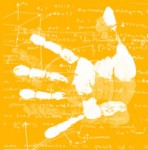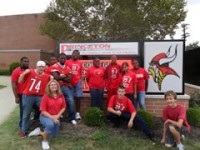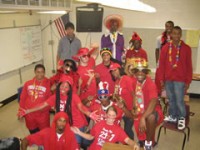
It’s also about looking beyond graduation rates and focusing on teaching kids the life skills they’ll need to succeed after high school—life skills such as introspection, goal-setting, conflict resolution, and time management.
“We have the highest graduation rate for African-American males in the state [98 percent], but that’s not enough,” Sprankles said. “Students need skills beyond graduating. Another purpose of CORE is to figure out how we can get the other two percent to graduate. It’s about every student, not just some.”
The CORE classes last about 22 minutes each day, and topics and projects are based on the Effective Schools Model, which is an organizational model for schools based on 40 years of research. Princeton High uses six of the seven correlates of this model:
1. Clear and Focused Mission
2. Frequent Monitoring of Student Progress
3. Safe and Orderly Environment
4. Opportunity to Learn and Time-On-Task
5. High Expectations
6. Positive Home-School Community Relations
Because students only have a limited about of time in CORE classes for projects or competitions, the school created a structure featuring a weekly topic that is connected to or driven by the purpose of each correlate.
CORE classes are based on a six-week cycle, with each week emphasizing a different correlate of the Effective Schools Model. The schedule looks like this:
Week 1 (Mission): Getting to know you; relationship games and activities; team-building activities.
Week 2 (Safe & Orderly Schools): Conflict resolution.
Week 3 (Frequent Monitoring of Student Progress): Setting my academic goals for first semester.
Week 4 (Opportunity to Learn, Time-On-Task): Organizational skills and time management at home and during the school week.
Week 5 (High Expectations): Building my four-year success plan beyond high school.
Week 6 (Positive Home-School Relations): “Where I Come From” poem; my family values.
Because there are six correlates and 36 weeks in a year, each correlate is discussed about six times per year.
Wilhelm described one goal-setting activity centered on a free-throw contest: “We had a basketball free-throwing contest, and the person who won would then be blindfolded and spun around, then we’d ask them to shoot. As you can imagine, they wouldn’t make the shot. We told them that this is like going through life without a goal, without aim.”
Another activity that struck the CEO was the “Where I Come From” poem. Each student writes two lines of poetry about where he or she comes from, then all the lines are joined together to make a complete poem that represents the students in the group.
“It’s heart-wrenching to read and to hear these students read, because you hear things like ‘Where I come from, men beat women,’ and ‘Where I come from, we are afraid of being raped.’ It really opens your eyes to these kids’ struggles,” Wilhelm said.
“You really get a sense of who your student body is, and what they’re going through,” said Sprankles. “Many teachers have framed this poem from the group they lead and have hung [it] on their classroom door for everyone to see. You just walk by and read these poems, and you have a snapshot of your school.”

Another major project for CORE classes will be to design a smart-phone app in January. Each group will work together to design the app, as well as propose an action plan for marketing. Out of the 100 proposals, the school will narrow them down to the top five to 10, and then the students will vote on their favorite. The winning group, with the help of netTrekker, will have its app built and put to market for 99 cents. All proceeds from the sale of the app, said Sprankles, will go to Princeton High’s “Innovation Fund.”
A similar project that involves student input is the opening of a new high school and a new middle school in April. Already, CORE classes are being asked to present a list of innovative concepts for these new schools.
For example, groups will be asked to present their advice for innovative curriculum and class structure.
“These kids, for the most part, have spent the last nine to 12 years of their lives in school; they probably have a better understanding of what works than we do,” said Sprankles.
In December, parents will be invited to Princeton High for a parent engagement session to discuss their thoughts on these new schools.
“This is what CORE’s about,” explained Sprankles. “It’s the first step in the broader direction to transform the education process.”
For Wilhelm, CORE isn’t just about prescribed activities; it’s also about sharing personal experiences and bringing in others to share what they know.
For example, Wilhelm has brought in his daughter to speak to his group about what it’s like being a college freshman.
“Before CORE was even officially started and I was speaking to student leaders, I met this great student, A.J., who had a lot of D-1 scholarship [offers] and was confused about where he should go. He asked me if he could call me to talk about it after school, so I gave him my cell number. We talked for about an hour and discussed his options and what I thought would be his best pick. Sometimes, it’s just good to have someone to talk to who isn’t a parent or teacher,” said Wilhelm.
Wilhelm has stayed in A.J.’s life, and he received a “shout-out” at A.J.’s decision-making ceremony at Lehigh University in front of A.J.’s parents and photographers.
“We really can make a difference with these kids,” said Wilhelm. “We at netTrekker really see this as a life commitment, and I’d be honored to attend my group’s eventual graduations, and even weddings.”
Not just fluff
Already, Sprankles said, teachers have noticed an improvement in student GPAs, and they believe it’s a result of the CORE classes.
While the evaluation has been informal, because CORE is only in its first year of implementation, Princeton High administrators looked at the average GPA of CORE groups (3.0) when CORE first started, and they compared the average in-progress reports and report cards since the program’s inception. According to Sprankles, the average has increased slightly.
“CORE gives students the time to reflect, and that’s important,” he said. “Most schools have to manage time and mandates with little time for reflection. But CORE allows these students introspection and the resources to set goals.”
Sprankles said student disciplinary infractions also have dropped as a result of the CORE classes.
The CORE curriculum is constantly being re-evaluated and updated as the weeks progress, he said.
“Some activities have not gone as well as I thought, and some have done even better than I thought,” said Sprankles. “Not all students embraced CORE at first, and some are still struggling with it, but that’s the whole point of doing it. Many students struggle to build relationships, and we must make this a priority every day, as it is a critical skill to be successful in the 21st century. … Change isn’t going to happen overnight, and we don’t expect it to, but it will happen eventually, it’s just a matter of time.”
As for Wilhelm and netTrekker, the twice-weekly bus rides to Princeton High are paying off in more ways than one. The company already has inspired other local businesses and agencies to support the school, said Sprankles.
For example, during each academic quarter, the school hosts a Community Partnership Breakfast that has now grown to include 75 to 100 business owners, CEOs, managers, and other community members.
For other schools looking to create something similar, Sprankles said the key to any school’s success is to involve the students.
“So often in education, we [adults] love to talk with each other about what is best for the students. We often forget the importance and value of taking time to ask the customer [students] for their input and their perspective and what their vision is. I would recommend creating a process where many staff members can contribute to the development of lessons and activities. Finally, I would recommend doing as many team-building activities as possible,” he said.
“Randy Wilhelm and the folks at netTrekker have set the bar for business-community-school partnerships. They have dedicated themselves to the development of our people, which is the most noble thing someone can do in public education.”
Links:
netTrekker
Note to readers:
Don’t forget to visit the Advanced analytics: Helping educators approach the ideal resource center. In the business sector, companies have been using predictive analysis for years to improve performance, predict stocks, or take action and change direction when troubling trends appear.
Go to:
Advanced analytics: Helping educators approach the ideal
- #4: 25 education trends for 2018 - December 26, 2018
- Video of the Week: Dealing with digital distraction in the classroom - February 23, 2018
- Secrets from the library lines: 5 ways schools can boost digital engagement - January 2, 2018




